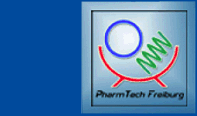Group Heiko Heerklotz
Modes of action of membrane-active compounds
Biological membranes control integrity of cells along with export, import, signaling, division, and many more processes. Hence, they are the target of a wide variety of biomolecules, drugs and excipients, as well as detergents and other membrane interacting compounds used in laboratory, manufacturing, and agriculture. Our aim is a detailed, mechanistic, and quantitative understanding of the intermolecular interactions and mechanisms the govern membrane insertion, leakage, demixing, or shape changes. Current studies involve, for example, lipopeptides produced by Bacillus, Pseudomonas and Streptomyces strains. Key methods of this project area are time correlated single photon counting (TCSPC) methods to characterize membrane binding, leakage, order, dynamics, and the positioning of molecules within the membrane. Isothermal titration calorimetry provides a comprehensive picture of binding processes and subsequent changes in membrane stability and structure.
Membrane asymmetry: Models, functions and applications
Virtually all biological membranes show an asymmetric distribution of their lipid species between the outer and inner lipid leaflet. The considerable effort to establish, maintain and regulate this asymmetry implies important functions of this asymmetry. However, owing to the fact that the vast majority of membrane model studies so far has been carried out with symmetric models (including liposomes), very little insight has been obtained into these functions. To overcome this problem, we have been establishing new protocols and procedures to prepare asymmetric liposomes based on enzymatic and lipid-exchange strategies. A key analysis to monitor asymmetry of ionic lipids is the zeta potential measurement, since zeta is unaffected by the molecules in the inner leaflet. We are interested in the impact of asymmetry on membrane protein function and possible bioactive agents acting by lipid scrambling. Asymmetric insertion or extraction of lipids or other molecules into or from one lipid leaflet creates a pressure asymmetry that promotes membrane bending and, ultimately, budding. This process is explored primarily by Asymmetric field flow field fractionation (AF4).
Stabilization of biologics in solution
Active pharmaceutical ingredients of many modern drugs are antibodies and other large proteins. They offer amazing activity and selectivity but are enormously challenging to be formulated into a stable drug product. Related to our interest in the thermodynamic parameters governing protein folding in general, we seek to understand and optimize the action of protein stabilizing excipients. This project is a collaboration with Boehringer Ingelheim. Important methods are DSC/PPC to desribe unfolding, ITC to quantify binding, and DLS to monitor colloidal stability. It turns out that the extremely complex and diverse mixtures of surfactants representing compendial surfactants approved for intravenous injection, including polysorbates and poloxamers, have unique properties that cannot be rationalized on the basis of text book knowledge on pure surfactants. Many years ago, a reviewer called our work on pharmaceutical surfactant products a “waste of good physical chemistry on dirty systems” – seeing “dirty” systems outperform pure ones in pharmaceutics, we are happy to “waste” our time on establishing at least some basic physical chemistry for them!
Lipid-based drug delivery systems
Lecithin, lysolipids, bile salts and other surfactants are used in a wide variety of drug delivery systems, including vesicluar lipid gels (VLGs), mixed micelles, emulsions, and liposomes. Our aim is a fundamental understanding and rational optimization of such systems that often have been developed on a largely empirical basis. Components of micellar drug delivery systems show specific interactions with plasma proteins that govern drug release.
